After a quick hit of spring, summer seems to have come. Sunrise is around 4.30am and sunset is 10pm. its not fully dark until maybe 11pm. With such long days come furious growth of all things green: our paddock grass is 3 feet tall, the footpath through the wood – Kelpie’s morning walk – has almost disappeared. Only the fact that we walk that we know the route like the back of our hands saves us from tripping over things hidden in the undergrowth.

THE HOLDING
Fruit has formed on the apple trees, currant bushes, and gooseberry bushes. We’ve got green strawberries. There are damsons and a few cherries on those trees. And we’ve got more than enough rhubarb – we’ve already eaten a couple of jars of rhubarb jam (thank you, Jenny) and rhubarb crumble.
The veggie patch is ok; it is further behind in its development than the well-established fruits, but everything is growing. No flowering yet.
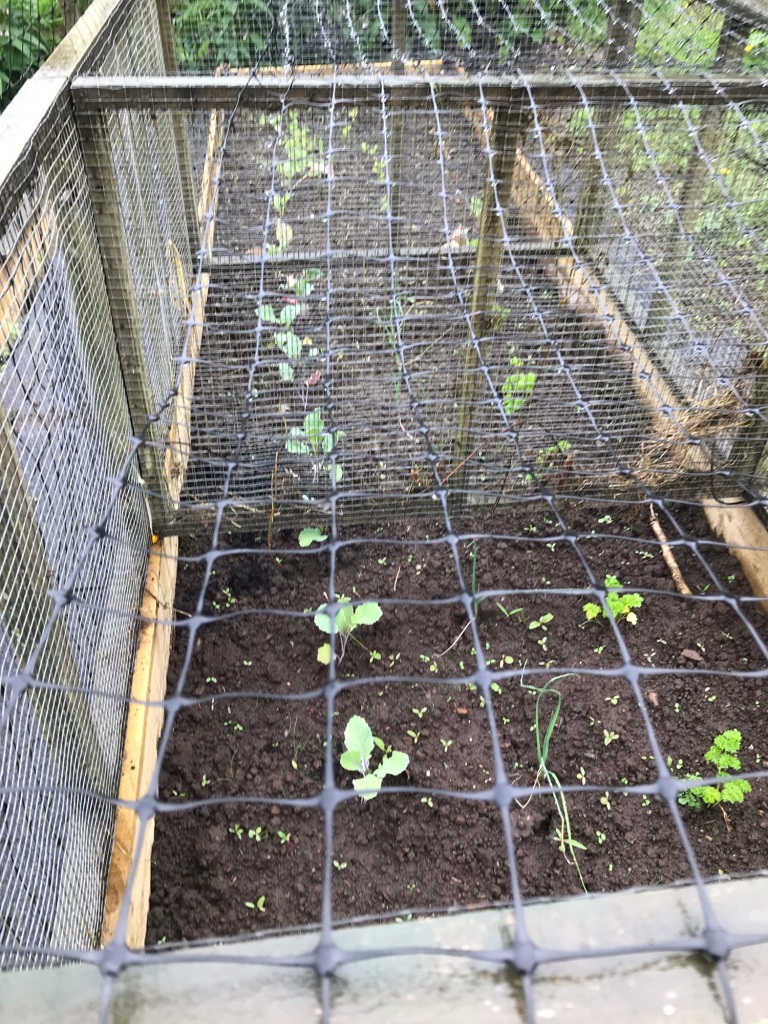



We’ve got a nice crop of wild flowers this year. We’ve had yellows, pinks, blues, and some whites and reds flowers. The vetches are beginning to bloom red, orange, yellow and purple, blue. Forget-me-nots are everywhere as are the buttercups. The wild orchids – we didn’t plant these – have pushed up leaves but no stalks yet. They are something to look forward to! We’ve also got twice as much ragged robin as last year. I wonder if the cows have made that much difference in a single year.
Next to bloom will be ox-eye daisies and clover.

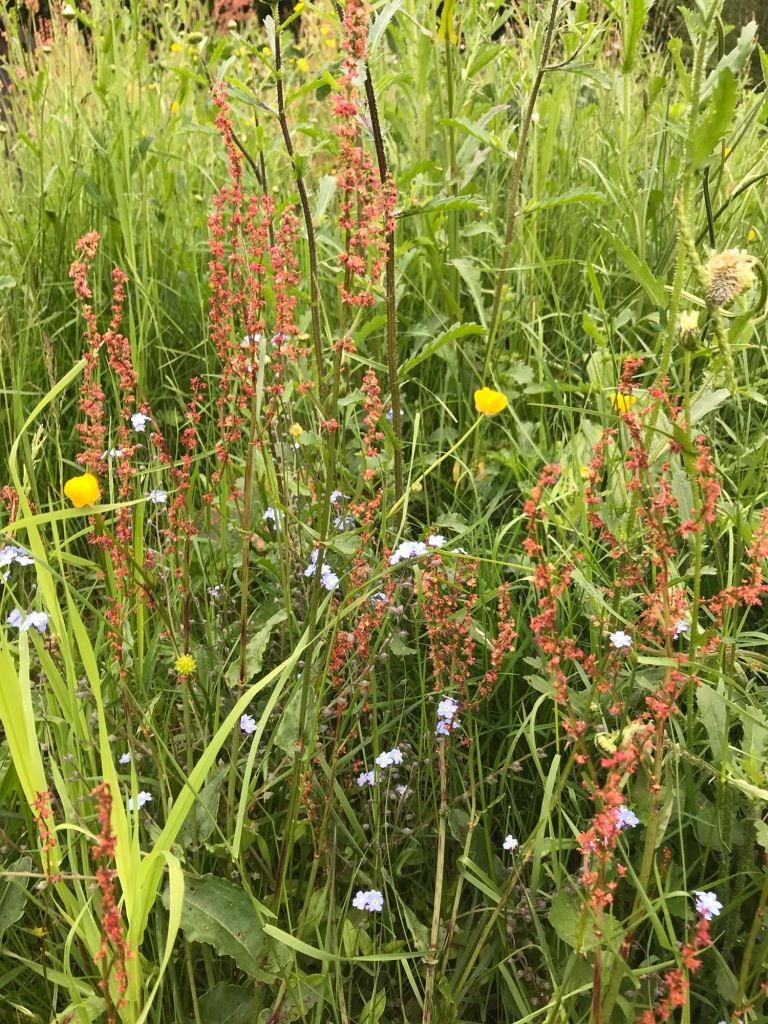

The pond is full of buggy life. Water-skaters, boatmen, diving beetles, damselflies, spiders, mayflies and other hatching flying things are there to enjoy. The tadpoles are still in the pond I think, living on the bottom mostly, trying to keep out of the way of the diving beetle larvae. Or maybe they’ve all been eaten.
I caught a glimpse of a newt in the pond which is very nice on one hand. But then I remembered last year’s horror at seeing 8 or 9 giant diving beetles all devouring a live newt. Don’t they know newts are a protected species? I’ve also seen an adult toad in the long grass, had a little wood mouse run under my feet, and seen a red squirrel crossing the road a quarter of a mile from here. We know the squirrels are around and it is lovely to even catch a glimpse.
We’ve had more orange-tip butterflies, and even some small whites which I don’t remember seeing before. There’s been a tortoiseshell or two, a red admiral and a peacock. too. I have noticed a lot of small white day flying moths this season. I do not recall seeing them before, and certainly not so many. So maybe the long grass and the added wildflowers are working well for those.
Phil has convinced me that we need a scythe mower. Anja and Emma have one now and they find it easy enough to use. I am not even sure what a scythe mower looks like, but hopefully it will allow us to cut the ‘lawn’ areas close to the house and keep the chicken paddock tidier. Until the scythe mower arrives, Phil is strimming to create footpaths through the grass, and has strimmed the chicken paddock. I then rake up all that I can gather and put it in the garden compost pile behind the hen house.


BEES
I’ve taken advice from more experienced beekeepers and fed the bees. I am now beginning to see an improvement in numbers which is a relief. I am also seeing them bring plenty of pollen in. Hawthornes have been in bloom along with fruit trees, campions and comfrey. I’ve seen two different shades of orange pollen and one that is very pale yellow, almost white, being taken in to the hive.
Since the bees are looking more numerous and stronger I am planning to do some work in the hive. I am going to attempt to cut through some brace comb. Ideally I would remove whole sheets of the stuff, keeping it as intact as possible, and then place it into empty wooden frames and secure it using rubber bands. Doing all of this will make it much easier for me to inspect the colony. It will also be quite disruptive to the bees, creating a lot of clean up work for them as cutting through any capped cells will cause leakage of stored honey and death to the damaged larvae. Hence the need to wait until the hive strengthens.
UPDATE on Bees: We are having another cold snap. There was snow in the Cairngorms earlier in the week, and it is very windy and the temperature here is not meant o get above 12 degrees centigrade for at least another 10 days or so. Because of this drop in temperature my plans with the hive have changes. I think I may try to cut through some brace comb so I can see between the frames, but I will not try to actually remove the brace comb now. When the hive is open it cools, and cooled brood will very likely die. I will need to wait for a very warm day to do the more invasive work.
Becuae the bees don’t come out when its cold, and the don’t fly very well when its windy, I will put another lot of feed on. It won’t hurt anything and it will help them if they are unable to forage for a few more days.
CHICKENS
Things are good. Nyx hatched her two eggs and both chicks are doing well. I have set up a Facebook page for smallholding stuff and there are several videos of the chicks over there. Here is the link: https://www.facebook.com/profile.php?id=61559753674856
We’ve got one broody lady in the hen house. This is Dorothy, Nyx’s twin. Last summer Dorothy and Nyx brooded alongside each other in the same nest box. This year Nyx got hit with the broody bug a month ahead of Dorothy. I wondered if I should let Dorothy sit on a couple of eggs, as I did with Nyx, but we are going to be away for a part of June and it doesn’t seem fair to our hensitter to leave her to look after and expectant mum and day old chicks.
We had another broody hen – Anna – who decided to do a sneaky nest in the undergrowth. We managed to find her on a nest of 15 eggs. 4 of them were broken, but 11 in tact and of these only one appeared to be a bit odd when candled. We found her and the eggs the first day is was absent from the henhouse so none of the eggs had been incubated long enough to have embryonic development. I didn’t feel right selling them, so we ate them.
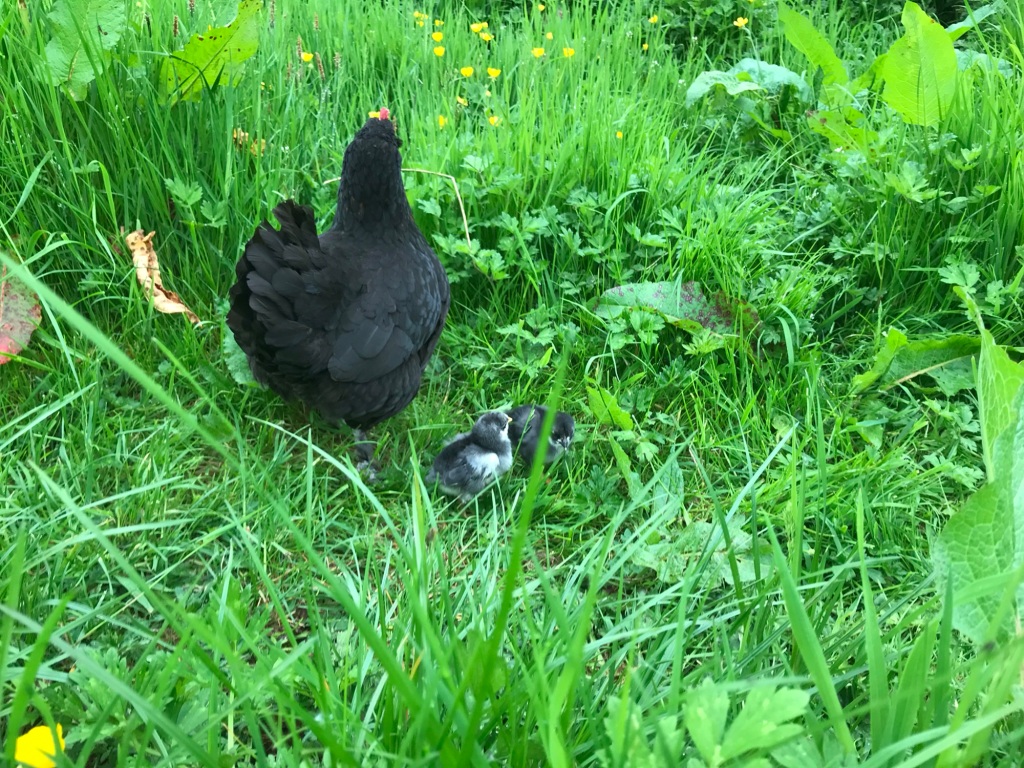

May and June, the chicks are growing nicely. May is going to be a solid black chicken and June is going to have some white feathers. Another anomaly of genetics! I had thought they were both hens, based on their behaviour alone: for the first month they have both stayed equally close to mama. This week I have notice June straying a bit, and I can see that their comb is growing. Hmm. June may be cockerel.
And just last night, Periwinkle didn’t make it home for bedtime. She was outside the front door this morning. So, she must also have a nest somewhere that we need to find. Kelpie and I will go have a look in the bushes now and see what we find.
GOATS
Sometimes having Lupus is very inconvenient. Goat Course Day finally came and I was feeling absolutely rubbish with a pounding headache and fever and a big nasty sore inside my nose (not nice!!!). I took plenty of painkillers, kept myself hydrated, and went. I wasn’t able to take in as much as I would’ve if I had felt well, but after a couple nights good sleep, I was able to recall more and begin moving ahead with goat plans.
The place we visited – the Lint Mill (https://thelintmill.co.uk/) – is a bigger holding than ours – about 10 acres, I think. They have chickens, geese, 2 kinds of goats, 2 pigs, a herd of Soay sheep, and an old horse or two. They’ve got a good veggie patch, fruits bushes, a young orchard, and a river running right alongside a couple of paddocks – and no fence. The river was very full and very fast. Scary! They also do B&B and lots of courses.
It was just 4 of us going for tuition. Anja and Emma (from Upper Barr) and in Phil’s place (because we decided it was too long a day for Kelpie to be on his own) Jamie. Jamie is a WWOOFer – ‘WorldWide Opportunities on Organic Farms’ from California. She is on a 6 month break after having completed university studies, and is travelling around Europe and South America working on farms. Very cool. She is a vegetarian. She did a good job listening to our conversations about the difficulty smallholders have of finding an ethical abattoir and butcher!
After coffee and an introduction to Deborah and Colin, we got a tour of the holding. Things I noticed: as breeding season is over, all of the ‘intact’ males are in separate fields, on the opposite of the hill, from their females and offspring. Soay rams and billy goats in their own fields, and goat does, and ewes and lambs in another their own. We don’t have enough space to separate animals like that so have no plans to keep a ‘billy’ – intact male goat.
We’ve goto 2 acres, Anja and Emma have 4, and the Lint Mill has about 10. It was good to see both the similarities and difference how things progress in terms of size, set up and management. So, it felt much like home (as does Upper Barr), but on a bigger scale.
Now, the goats. They have 2 breeds, both classified as rare. Bagots – long hair, shaggy goats, black and white, flighty – are an old breed. They are more difficult to handle because of their temperament so are most likely used as show pieces, meat, or conservation grazers. They remind me of mountain goats. The other breed they keep are Golden Guernsey’s also listed as a rare breed. These have reddish coats with varying amounts length. They can be almost blonde or almost deep auburn. They are dairy goats.
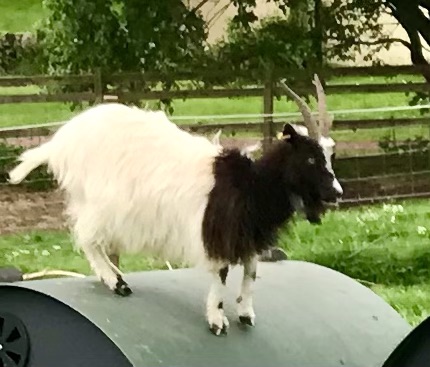

One of the cool things about goats is that with regular milking, they can produce milk for up to two years after kidding (sheep= lambing, cow – calving, goat = kidding). That means they only need to be bred once every two years instead of every year like cows. Another cool thing about goats is that they are smaller than cows. This makes them (especially the females which are called does) less intimidating than cows. Yet another cool thing is they are curious about people. One thing pointed out to us about the difference between sheep and goats: sheep run away, goat run to. That certainly makes handling easier.
We met their three nannies (a doe with kids). Two of them had new kids; the third one hadn’t kidded this year but was still producing some milk. We got the opportunity to do a bit of miking with her.
I have not yet milked a cow, but milking a goat seems like it is going to be quite a different process because of the difference in anatomy. Rather than having long teats that require a whole human hand to mimic the action of a calf’s mouth, goats have much smaller teats and you can’t grab hold of them. This was particularly noticeable because these goats were newly kidded: their udders were stretched full making the teats invisible. Milking them was like squeezing a water balloon. The milk then came out of a pinprick hole in the balloon.
Squeezing the milk out took a fair bit of pressure, but it wasn’t painful for me (can’t speak for the goat). Instead of it being about using only the fingers around a teat, it was using the whole hand to squeeze the udder. I might be able to do this! And, interestingly enough, two of my neighbours have kept goats for many years. So I have back up!
It was a long day and I was very tired, so it took a good night’s sleep and another day or so to process everything. During that time I wondered if my health was such that it was ridiculous to even think about getting any livestock. Then I thought about the long grass and decided it would be easier to let the animals manage the grass maintenance than Phil and I. In addition to that we will get good fertiliser and fresh milk…so

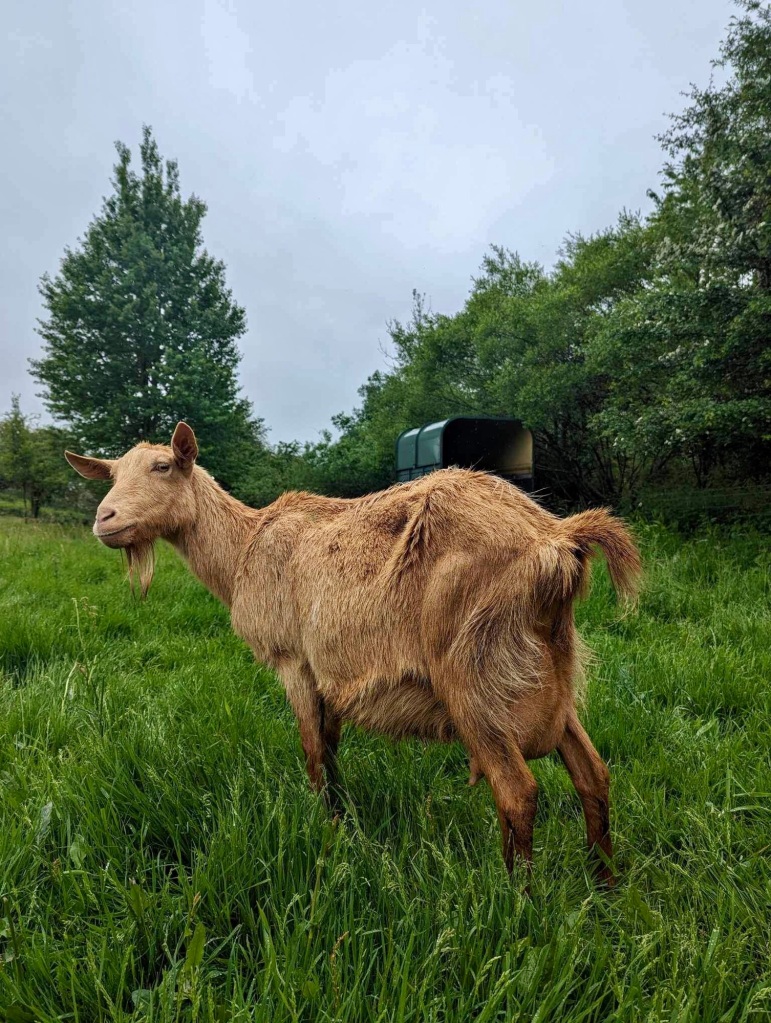

I’ve ‘ordered’ two goats, each with two kids. One of them is Clemmie from the Lint Mill; and the other is Whinpot Aya from a farm in Kendall. Between the two, there will be three wethers (that’s a castrated male) and one little doe. So, in two years time, the nannies will be ready to breed, and so will the doe. The wethers will help with the landscaping and should be great fun to get to know and enjoy.
The timings of picking up the goats is dependant upon Phil and I getting everything up and running here. Seems like the end of July is when the current owners expect the goats to be moved on, so we will do our best to work to that target. By the time of my next blog, I will be able to share more of the getting ready process.

